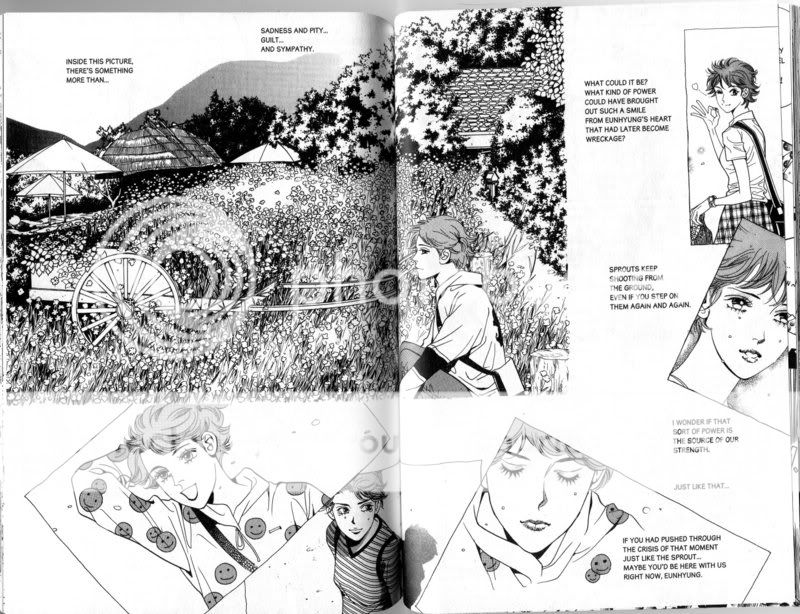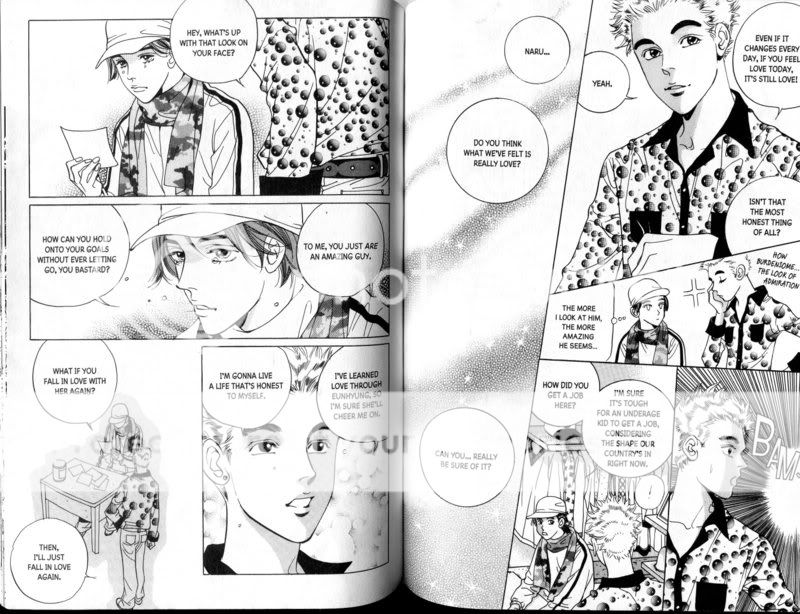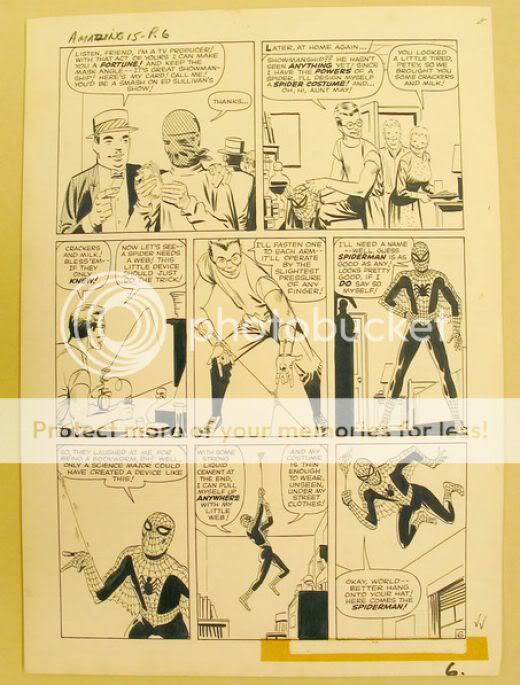One of the fun things about Bill’s post is that it puts chip-on-the-shoulder manga defenders like me in our place. I mean…why do you need to defend manga anyway? From what? Certainly, manga in Japan is facing a lot of challenges right now, but those challenges just can’t be said to include moderate skepticism — or, for that matter, outright hatred — on the part of some American consumers.
So, having admitted my defensiveness is kind of ridiculous, I’ll proceed with it anyway. One thing Tom said in comments kind of bothered me:
On the pacing issue … to me the problem isn’t so much fast pace, since I like speed in comics, just the idea that on any page of manga all you’ll get is picture-word balloon-sound effect, with the word balloon constrained to hold not much at all. For example, I like the caption-picture juxtapositions Moore and Gaiman used to do in the 80s. I gather that in manga such tricks are impossible and so are any other word-picture gimmicks/innovations a clever writer or artist might come up with. Yikes.
I don’t think that’s right. Yes, manga is designed for faster reading, and uses fewer words than American comics. But I think that manga-ka use a lot of thoughtful word-picture juxtapositions. In comparison, I think a lot of Moore’s tricks (using quotations to comment on different action sequences, juxtaposing image with image to fade from one scene to the other, etc.) are pretty clunky (though I often like the clunkiness; Moore’s heavy hand is its own kind of pulp sublime.)
Anyway, I thought I’d look at a couple pages from one of my favorite series, Let Dai by Sooyeon Won. It’s from Korea, so it reads left to right. I chose these pages more or less at random. Here’s the first:
Here the characters are looking at a series of pictures of a friend. So the panels here become the photographs. The upper-left image is very detailed, suggesting the sharpness of the memory. The rest of the images are distributed around the page, like photos spread out. One of the pictures on the right is actually cut off by the page edge. So you go from a very vivid memory to a sense of diffusion or loss; of a memory cut off and lost. The text at the same time is questioning the memory, “Inside this picture, there’s something more than…sadness and pity…guilt…and sympathy” and then on the other side of the page, “If you had pushed through the crisis of that moment just like the sprout…maybe you’d be here with us right now, Eunhyung.” The text, in other words, is encouraging you, not to fast forward through these images, but to look at each picture of her face to try to understand her, and why she is gone — an understanding which can, of course, only be partial (again emphasized by the fact that the pictures are partial and in one case actually cropped off.)
Here’s the following page:
This is less daring, obviously, but there’s still a fair bit going on. I like the way, on the second page, the conversation shifts to being more philosophical, about love and uncertainty, and so the image turns to just designs and filler; a sort of celestial, indeterminate test pattern, I also like the move to hyperdeformation in the middle of the second page. “The more I look at him, the more amazing he seems” thinks Jahee (in the baseball cap) and this sort of goofily childlike idea visually infantilizes him.
I mean, obviously everyone isn’t going to like this. You might not like the melodrama, or, like Miriam, the art may not do it for you. But I think it’s pretty clear, even in just these two pages, that the creator is attentive to how words and images go together, and that she uses various techniques and resources to combine them and tell her story. Certainly, she’s got more going on than this stuff, where the pictures and story both go happily on their way as if completely unaware of each other:
I’m just sayin’, is all.
Going back to Let Dai for a moment, Miriam asked in her post:
Can you take a really good shojo or shonen manga, and read it several times, and see different shadings or interpretations each time? If not, then I guess I’m not the target audience for shojo manga, much as I love romance and heartbreak and interpersonal intrigue and all that stuff.
I haven’t read Let Dai over, not because I don’t think it could take it, but because I’m not sure I could — reading it the first time kind of reduced me to a weeping wreck, and I’m not ready to go there again. But…yeah, the manga series I’ve loved have totally held up on rereading. For what that’s worth.
Update: Hey, look, something on the Internet that pisses me off! Katherine Farmer responds to Tom’s post by throwing herself at her high horse, missing, and bashing herself in the head.
What’s more, it irritates me intensely when people stand up and say “I am ignorant; educate me!” when, frankly, the resources are out there for them to educate themselves if they cared to put the effort in. I considered making a comment to Crippen’s post, but decided against it, because hey! I don’t actually give a damn if he likes manga or not, and it’s not my job either to do his homework for him or to defend the honour of manga. Manga needs no defence, from me or from anyone else.
Okay. But then why do you go on and on snarkily defending it? Why brag about how you didn’t leave a comment because you don’t care and then write a gigundus post about how much you care?
It’s a freakin’ conversation, not an exercise in moral climbing. Take a lude. And stop making me embarrassed that I like this stuff, would you?



